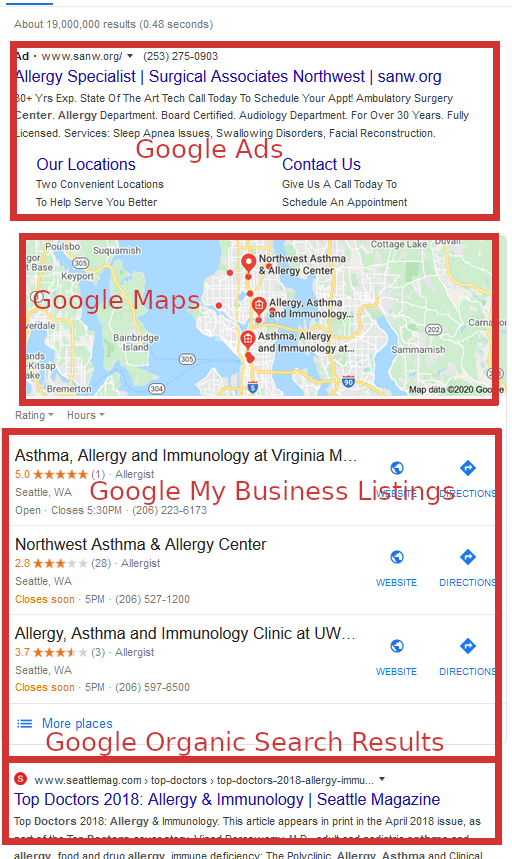Why should medical practice owners and practitioners invest in digital advertising over other advertising channels? The answer is simple: increased website traffic and more patients. Online advertising for doctors is a necessary part of any digital marketing strategy.
In today’s digital age, many of the traditional advertising channels business owners have long relied on are becoming obsolete. Newspapers are slowly fading into the background, direct mailers get tossed straight in the trash, and TV viewers change the channel as soon as commercial breaks hit.
How then, do doctors market to an audience so intent on ignoring traditional advertising?
They leverage the two largest digital advertising platforms on the planet: Google and Facebook. Here’s the rundown on how Google and Facebook advertising work, what practitioners need to know to succeed, and how to determine a practice’s return on digital advertising investments.
With 5.8 billion searches per day, Google is an absolute behemoth in the world of digital ads. Facebook is a close second, with 1.62 billion daily users — if clinics are not currently taking advantage of the flood of traffic these platforms handle on a daily basis, they’re undeniably sacrificing their bottom lines.
Google Ads for Medical Practices
Google Ads, formerly known as Google AdWords, is a type of paid search, and it’s arguably the most powerful digital advertising tool at your disposal. With a properly optimized and targeted ad campaign, Google Ads can deliver traffic, leads, and patients in as little as a day. Compare that timeline to the estimated four to six months required for organic SEO traffic to kick in, and you can clearly see the value of paid search.
So what exactly is Google’s paid search?
Google’s paid search puts a medical practice at the top of Google’s search results for specific keywords. For example, the screenshot below displays the results for “Seattle allergy doctor” search. The results show Google Ads above Google Maps, Google My Business listings and Google organic search results. Google Ads operates using a pay-per-click model, meaning practice owners only pay for their ads when someone clicks on them. A practice owner’s cost per click (CPC) depends almost entirely on the keywords they choose to target.

How much does Google Ads cost doctors?
When the return on investment warrants spending on digital advertising, Google Ads is a great way to get to the top of search results. Higher volume keywords typically cost more, while keywords with lower search volumes generally cost less. Typically, cost per click ranges from $1 to $30, but for highly competitive keywords, the cost can exceed $50 per click.
For example, a bariatric surgeon who wishes to advertise on Google might choose to target one or more of the following keywords:
- Bariatric surgery
- Bariatric surgery + location
- Lap-band surgery near me
- Weight loss surgery
- Weight loss surgery near me
- Gastric bypass surgery
Though each of the above key phrases has substantial search volume, selecting those most appropriate for an advertising campaign depends largely on intent and location. Because Google can be very competitive, narrowing target keywords is essential to avoid getting buried among the competition.
How to optimize Google Ads for doctors’ offices
For a Google Ads strategy to produce a significant ROI, it’s critical that practitioners know exactly what they’re doing when creating a campaign. If they target the wrong keywords or market to the wrong audience, they could end up shelling out thousands of dollars with little return. A successful PPC campaign should focus on the following elements:
- Appropriate keyword targeting
- Optimized ad copy
- Unique selling proposition
- Optimized call to action
- Additional site links
- Audience intent
- Age of target patients
- Gender and sex of target patients
- Location targeting
To construct an optimized ad, practitioners must begin by conducting keyword research, audience research and competitor research. After setting up the initial ad, they’ll need to create variations on that ad for A/B split testing, which helps determine the keywords and structure that drive the most traffic.
But that’s not all: physicians must also constantly re-optimize campaigns to edge out the competition. It’s a highly involved process, which typically requires substantial trial and error for professionals with limited digital marketing knowledge.
If medical practices hope to achieve lasting, revenue-boosting results, a reputable digital marketing team and PPC partner is their best bet for success.
Unfortunately, when it comes to paid search for busy medical practitioners, trial and error isn’t just time-consuming and inconvenient; it can become very costly.
While Google certainly offers other advertising options for marketers, healthcare advertising on Google is rife with restrictions. Unless practitioners maintain up-to-date knowledge of Google’s ever-changing policies and algorithms, they risk ad disapproval or worse, a Google Ads suspension or ban.
Facebook Ads for Medical and Dental Practices
Facebook, the second-largest global digital marketing platform, scooped up a whopping $55 billion in ad revenues in 2018, and that number is only projected to grow. Why? Because Facebook ads work, and they work very well. According to recent survey statistics, cost per conversion for Facebook healthcare ads averages just $12.31 — lucrative is an understatement.
Facebook advertising is unique in that medical practices can target users based on highly relevant audience demographic information, including age, sex, ethnicity, location and language. Ad targeting can also be designed around user likes and behavior for specific pages or topics. Essentially, Facebook allows practitioners to target the lowest hanging fruit for a medical practice — individuals who’ve already expressed an interest in or desire for a particular medical service.
According to 2019 data, Facebook healthcare ads enjoy higher than average click-through rates at 0.8%, and a lower than average cost-per-click at $1.32. The best part? Overall, healthcare ads have an astonishing average conversion rate of 11.00% — one of the highest CVRs among all industries!
When it comes to advertising costs, like Google, Facebook follows a cost-per-click-model; however, their pricing approach doesn’t depend on keyword selection. Rather, a variety of factors influence a Facebook ad’s cost per click, including:
- Objective of the ad
- Advertising industry
- Ad quality
- Audience
- Bidding type and amount
Within the Facebook ads platform, practitioners can specify ad objectives, which denote the intended goal of each ad. Facebook has three core objective categories: awareness, consideration and conversion. After selecting a core objective, practitioners can then refine their objective further by selecting highly specified objectives, such as brand awareness, traffic, engagement, lead generation and conversions, among others.
From Facebook, advertisers can drive traffic to various web-based locations, including the practice website, to further educate users on the value of their services. Ideally, users who click through from a Facebook ad will land on the practice’s site, gather further information and ultimately, book an appointment.
But success isn’t so easily gained in the world of social media.
A successful social media advertising campaign hinges on several factors, many of which require expert knowledge in the social media and advertising spaces. For any Facebook ad campaign to be successful, practitioners must:
- Use eye-catching visuals — 54% of users prefer video content.
- Create compelling, high-converting copy.
- Implement a compelling call-to-action without sounding “salesy.”
- Align ad content and landing page content.
- Conduct A/B split testing.
- Determine appropriate ad placement.
- Target the appropriate demographic.
- Use conversion pixels to track and re-market leads.
- Retarget warm leads.
- Use geographic targeting.
But that’s not all — to place ads in front of the right audience at the right time, practitioners must develop an ad budget and design a bidding strategy. To ensure target audiences view ads as frequently as possible — and to outperform your local competitors — you must optimize your bidding strategy.
Unless clinics are looking to burn through their ad budgets with little to show for their efforts, professional advertising assistance is key to Facebook ads success.
When practitioners purchase ad space on Facebook, they’re essentially joining a massive auction. In that auction, competitors are constantly attempting to outbid each other for highly coveted ad real estate. If clinics bid too low, their ads won’t get the exposure they need to convert; if clinics bid too high, they might end up throwing money down the drain. When the ad network is overly saturated, only the highest bidders will get the ad placement they need for success.
Facebook is a complicated, ever-evolving ad machine — but it’s highly cost effective and boasts an impressive conversion rate for digital healthcare marketing. Success on Facebook requires practitioners to maintain up-to-date knowledge of ad trends and best practices, which is an education in and of itself. Not to mention, advertisers must comply with Facebook’s strict rules and regulations regarding content, or they risk being banned from the ad network.
Digital Advertising for Medical Practices: Calculating Return on Investment
ROI is the ultimate determinant of an ad campaign’s success — but what exactly does it mean, and how do medical practices calculate if they’re in the black?
Return on investment for a practice’s digital marketing campaigns denotes the practice’s cost per patient acquisition. On a very rudimentary level, an ad campaign’s ROI is calculated by dividing the amount of money gained by the amount of money spent.
But in real life, calculating ROI is not that simple. Here’s a basic idea of how to do it:
- Determine the total cost of advertising.
- Gather the total number of new patient inquiries.
- To calculate the cost per lead, divide total advertising costs by the number of new patient inquiries.
- Determine the conversion rate from inquiry to appointment.
- To calculate the cost per appointment, divide total advertising costs by the number of new patient appointments.
- Determine the patient conversion rate from initial appointment to treatment.
- To calculate the cost per conversion, divide total advertising costs by the number of converted patients.
- Calculate ROI by multiplying the number of converted patients by the average treatment cost. Divide that sum by the total cost of advertising.
Plenty of steps, right? Plus, clinics might see potential patients who book initial consults but don’t follow through with treatment for financial reasons. Later, some of those patients may return for treatment with improved financial resources, which further complicates ROI calculations.
So what’s the best way to ensure medical advertising campaigns are profitable? Optimized campaign construction combined with diligent and accurate analytics tracking. To top it off, expert insight into campaign data provides invaluable direction for a practice’s ongoing digital marketing efforts.
The Bottom Line?
Digital advertising is an intricate and ever-changing art — but it’s incredibly practical and effective. With the appropriate tools and knowledge, developing an effective digital advertising strategy can yield a substantial ROI. Lack the necessary expertise, however, and you could waste substantial time and money on fruitless marketing efforts. When the success of your practice is on the line, it’s best to trust digital advertising to experienced professionals.

